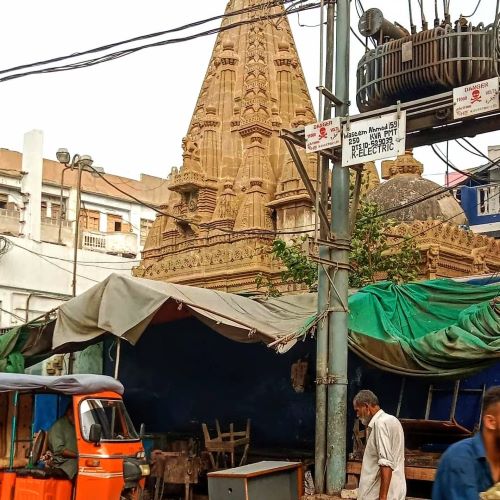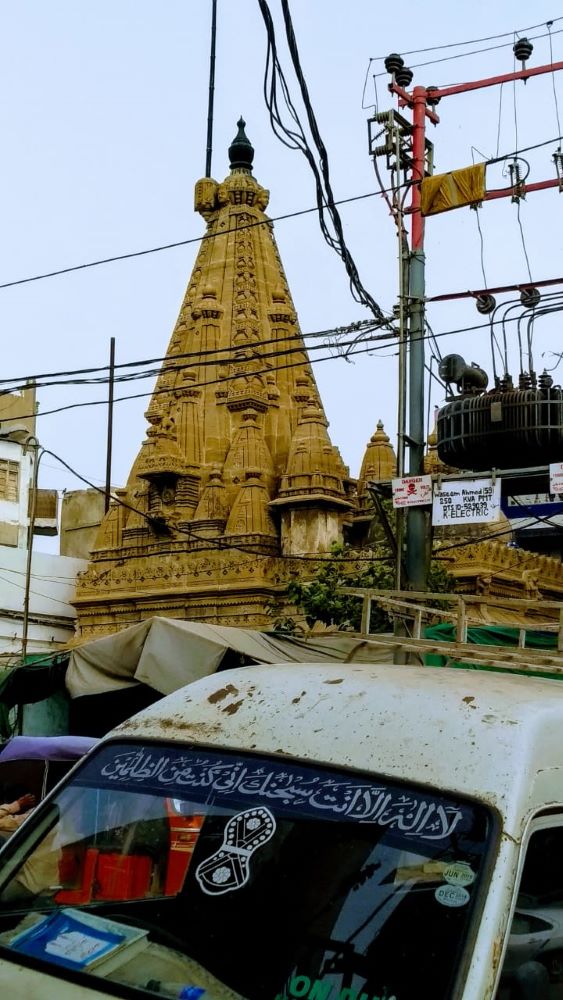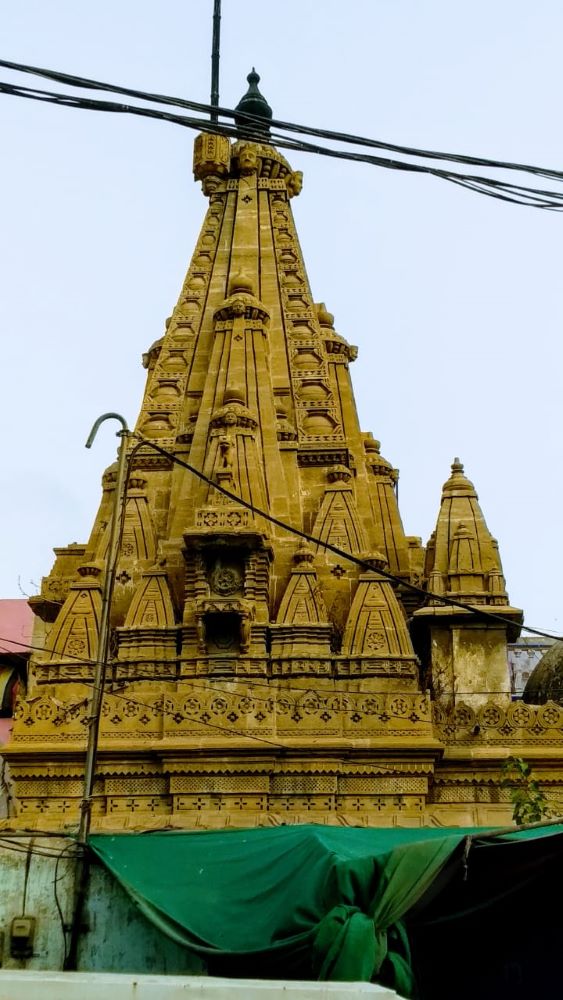
Temple, with depictions of Hindu gods and relics, is encroached on from all sides in every way possible
Afsar Jatoi
Karachi has been host to diverse communities ethnically, linguistically, and religiously. These various communities lived harmoniously throughout history. The city had been home to many temples, mosques, synagogues, and Jamaat Khanas. However, things started taking a shift after the partition of Hindustan and the demography of the city changed exponentially. Hindus which comprised 47.6 percent of the Karachi population at the time of partition were forced to migrate and hundreds of thousands of Muslim people from different parts of Hindustan came to Karachi as refugees and settled here. Almost all of the Hindus of the city left. Similarly, the Parsi colony lies relinquished and the Parsi community that lived here and made the city prosperous through their business and made public spaces, hospitals, and schools through their philanthropy is nowhere to be found. The partition remains one of the most tragic events of the twentieth century and changes that took place in a matter of months remain indelible seventy-five years later. A Pakistani historian Ayesha Jalal describes partition as “a defining moment that is neither beginning nor end, partition continues to influence how the peoples and states of postcolonial South Asia envisage their past, present and future.”
 If this situation persists and steps are not taken to preserve this heritage, these historical structures will be eroded silently and all will be gone
If this situation persists and steps are not taken to preserve this heritage, these historical structures will be eroded silently and all will be gone
Several Hindu temples could be witnessed in various areas of the city which were made and managed by Hindu Sindhis who lived here. Now, only a few of them are functional today and most of them are defunct.
As usual, out of sheer curiosity, I along with two of my friends were roaming around in Saddar, which is a central business district of Karachi, where hundreds of buildings belonging to the pre-partition era can be found. Walking along M. A Jinnah road, we snuck into a street on our left which is called Rattan Talao. On both sides of the street lie the fine pre-partition buildings mostly made of Jodhpur red stone and yellow Gizri stones. The architects of that time loved as much the hue of the yellow stone as it could be found in abundance from nearby Gizri hills. These historical buildings are in very dull condition and on many of them, white color paint has been attempted very badly which make them look disgusting. As the buildings consist of two floors, the ground one is occupied mainly by shops where men can be found doing repair work on old parts of automobiles and motorbikes, and the floor above ground either lies impoverished or gets utilized as a warehouse. These buildings belonged mainly to the Hindu community who migrated around the time of partition. The neighborhood once was home to various communities and the architecture representing various communities, which is in pretty tattered condition nowadays, is a testament to its pluralistic, diverse, and cosmopolitan past.
People call the abandoned temple by the name of ‘Ramachandra’
As we marched further into the Rattan Talao Street looking up all this time imagining the era when the neighborhood was flourishing with all its hustles and bustles, we encountered a tall conical structure apparently a Hindu Temple as depictions of Hindu gods and relics can be witnessed on its surface. It was encroached on from all sides in every way possible. We went around and searched for the gate. There was a gate that could potentially be an entrance, but to our disappointment, it was locked and a slate was hanging on its corner reading some random trading company’s name. We asked but the irony is that many people working there do not know about these historical gems. Luckily, we found a man in a shop who told us that it’s been decades since this temple is padlocked and they don’t know who has the keys. People call it by the name of Ramachandra’. It is possible that Bhagwan Ram might have come and lived at this place during his exile as a similar myth is famous for his visit to Shree Panchmukhi Hanuman Mandir in the neighboring Soldier bazaar and Rambagh, a garden named after him.
 School boys left murmuring, “ye Hindu itni azadi se kese ghoom rahe hain yahan” (How come these Hindus are roaming around freely here)
School boys left murmuring, “ye Hindu itni azadi se kese ghoom rahe hain yahan” (How come these Hindus are roaming around freely here)
As we were discussing all the possibilities and probabilities about the temple, two young lads in school uniforms who were passing by stopped and started listening to us curiously. They were pretty surprised to know that this structure was Mandir as they were passing by from here daily and didn’t have any idea about it. They were pretty annoyed when they found out that one of my friends is Khatri Hindu. They left us by murmuring, “ye Hindu itni azadi se kese ghoom rahe hain yahan” (How come these Hindus are roaming around freely here). It is alarming how deeply our society has been radicalized that the youth cannot tolerate the presence of a fellow human just because their belief is different from theirs.
We went further into temple road and found an interesting slate on an entrance of a mosque which was written in Gujarati and there was also Urdu translation beside it. Indeed, it was a rare sight of co-existence, diversity, and pluralism in today’s fundamentalist and puritan environment where even alphabets and languages are associated with religion. One would wonder how a language can be Hindu or Muslim. As a nation, Pakistanis have no interest in learning about their history. Thus, they easily become victims of the regressive and degenerative narrative. Historians like Manan Ahmed Asif tell us that the word “Hindu”, historically, was used to refer to people living in Indian Subcontinent, including Muslims. Similarly, the conquerors from outside would be identified for their linguistic and ethnic backgrounds.
It is just the development of the colonial era when identity shifted from language and ethnicity to religion.
The very next morning after my visit, I woke up to the terrible news of vandalizing of the temple by the builder mafia in the dark hour of the night with proper planning under the supervision of police in soldier bazaar area of Karachi. (Certain reports suggest that a woman, said to be the daughter of Hindu Pandit, had occupied the temple building and shifted the statues to a small room about a decade back, and now she sold out the main temple building to a builder. The dispute was going on since long as Hindu community unhappy with what what the lady had done).
Another temple was shattered down to the ground by dacoits using rocket launchers in Kashmore area of Sindh in a reaction to a woman named Seema going to India to marry the love of her life. If this situation persists and steps are not taken to preserve this heritage, these historical structures will be eroded silently and all will be gone. It is sad to see this state of affairs. This same region was much more pluralistic and tolerant in the past. If we cannot move forward and make progress for the future, at least we should take a look at the cosmopolitan history of the region and learn something from it.
______________
 Afsar Jatoi is a researcher and student of anthropology at the Department of Anthropology and Archaeology, University of Sindh Jamshoro. Email: jatoiafsar0@gmail.com
Afsar Jatoi is a researcher and student of anthropology at the Department of Anthropology and Archaeology, University of Sindh Jamshoro. Email: jatoiafsar0@gmail.com
[…] Also read: A Tale of Abandoned Hindu Temple in Karachi […]